If you're new to knitting and wondering what all this "gauge" and "swatch" stuff is all about, here's a quick overview of those terms for you, before we jump into the why and how.
A swatch is simply a rectangular piece of fabric that you knit prior to starting a pattern as a test. You do this for a few reasons: to see if you like the yarn, the drape, to see if the yarn bleeds, and very importantly, to test gauge.
Gauge is the number of stitches that fit into rows/rounds per inch. You'll find a suggested gauge in all knitting patterns, the goal is to match the pattern's gauge with your swatch gauge so that your knitting matches the look and final dimensions of the pattern. You may be wondering why you won't get the same gauge as the pattern if you use the same yarn weight and needle size - learn why your gauge may be different below.
TIP: If your gauge doesn't match just slightly we recommend altering the needle size or yarn weight up or down accordingly. If you have a significantly different gauge, this knit tutorial may do the trick for you "How to Modify Gauge"








Comments
Hi Fiona,
Yes, Julie always wet blocks her swatches because she wet blocks her sweaters.
Blocking for sweaters is different than blocking lace. With lace you will pull and stretch to open up the lace pattern. With sweaters you will only block to the measurements you knit the sweater to, often just patting the the pieces into place.
When you wet block your swatch, do not stretch it, but pat it and let it dry. See our tutorial “How to Wet Block” under Knitting Tutorials above.
I’ve been advised to wet block swatches. My question is do you think this is a good idea and I’m thinking surely if you pin a wet swatch to a blocking board when it dries it is bound to be the size it was pinned to which defeats the idea of knitting a swatch to find out if tension is correct ?
Hi Susan, Yes, you do count the purl stitches in the rib. We’ve found that with this fabric it is critical to wash your swatch because it tends to spread out horizontally (so you get fewer stitches per 4" after you wash it). If you have been washing your swatches or need more help, feel free to email us at knit@cocoknits.com.
My question is how do you count your gauge stitches in the half fisherman’s rib for the Sarah. I have tried a 6,7,8 needle size using magpie dk swanky. So the question is do you just count the “V” or do you count the V and the hidden purl stitch. To get 14 stitches for 4 inches I am having trouble with the fabric looking loose and not puffy.
Thank you.
Hi Jayne, Julie doesn’t find it necessary to swatch in the round because the Cocoknits Method begins with flat knitting. But if you want to double check that your in-the-round gauge is the same as your flat gauge, you can find lots of great video tutorials about swatching in the round on YouTube.
How do you knit a swatch on the round. I often see swatches that have strings hanging from each side.
Hi Janet, Welcome to the KAL! Have you blocked your swatch? You may find that the ribbing changes during blocking, so you will want to take that into account. If you want it looser after blocking, go ahead and use a larger needle, as long as you like the way the fabric looks. Feel free to email us at knit@cocoknits.com if you have more questions.
Hello. I am swatching for the Toni KAL, using a colour block design and am finding that one colour-way knits up differently from the other two of the same yarn. Is this common? I’m using Woolstok Worsted from Blue Sky Fibres.
The one that knits differently will be the ribbing. I notice you don’t change needle size for this, but my ribbing does pull in a little, so am wondering about using different needle sizes, bigger for the ribbing.
Any advice on either issue?
Hi Beverly, Yes. Sometimes you will find that a pattern gauge is given for Stockinette Stitch, even though the piece is knit in another stitch. In that case you are best knitting a swatch that includes 6" of the pattern st and 6" of st st. Hope that helps!
I have not specifically read that a swatch should be in the stitch pattern of the final piece, but I am assuming it should be. Can you confirm?
Hi Susan, The listed gauge for Vintage is 4.5-5 sts/in, while the gauge for Franca is 4 st/in and Julie suggests that you knit it firmly, as the long cardigan can stretch. Check with the people at Wild and Wooly, but you may want to knit this at a tighter gauge—either with the size 8 needle, or whatever needle gets you the fabric you want. Julie will be adjusting the sweater pattern as she goes along because she is knitting it at 4.5 st/in. Between help from Wild and Wooly and Julie’s hints, you should be able to modify as you go along as well. Hope that helps and feel free to email us at knits@cocoknits.com with more questions.
I am Franca with Wild and Wooly in Mt Pleasant SC using Vintage by Berrico 52% acrylic 40% wool 8% nylon. I am trying to get a gauge I know I knot loose. 16 stitches by 24 rows on a 10 needle I get 4 1/4 by 5 inches. With a 9 I get 3 3/4 by 4 3/4 inches with a 8 I get 3 1/2 by 4 1/4 What size should I use
Leave a Comment